Electron paramagnetic resonance studies of the high-spin molecule Cr10(OMe)20(O2CCMe3)10 -: art. no. 03250
APPLIED PHYSICS LETTERS 86:3 (2005) ARTN 032507
Magnetoresistance Techniques Applied to Fermi Surfaces
Chapter in Encyclopedia of Condensed Matter Physics, Elsevier (2005) 253-261
Muon‐Spin Rotation Studies of Molecule‐Based Magnets
Chapter in Magnetism: Molecules to Materials, Wiley (2004) 235-256
Magnetic phase separation in EuB6 detected by muon spin rotation
(2004)
Muon spin relaxation in DyVO4 and TbVO4
Physical Review B - Condensed Matter and Materials Physics 70:21 (2004) 1-4


